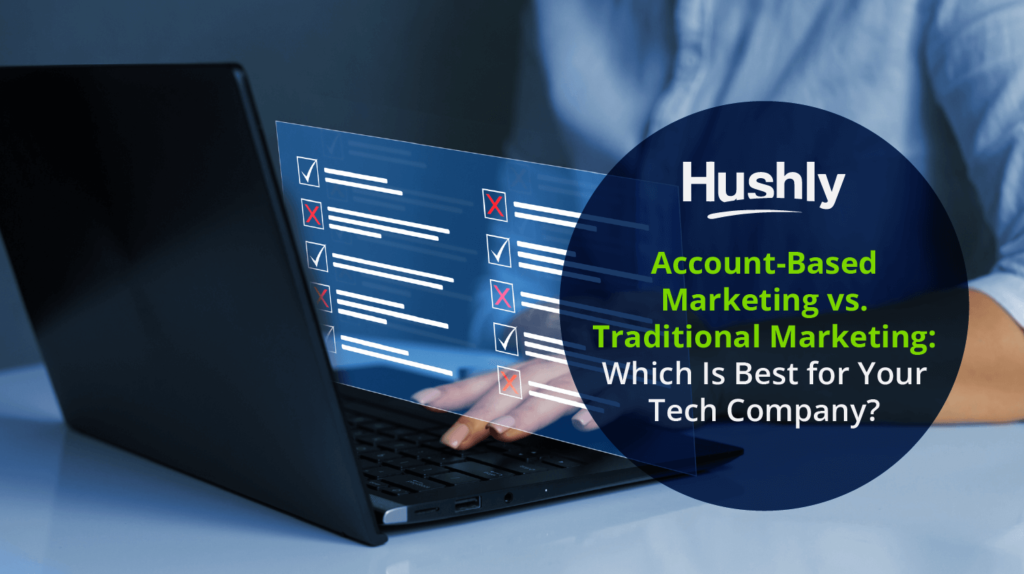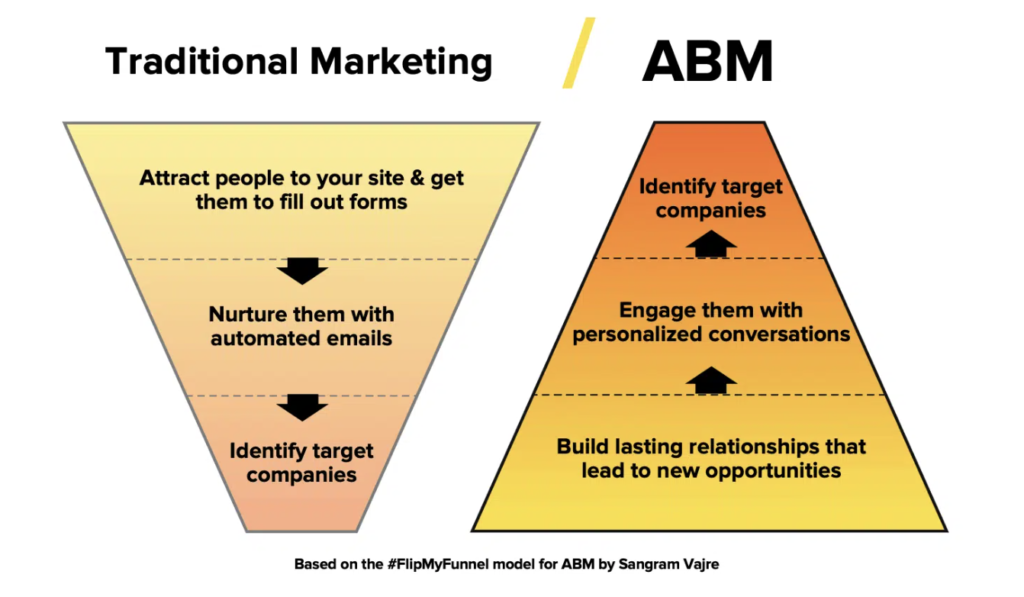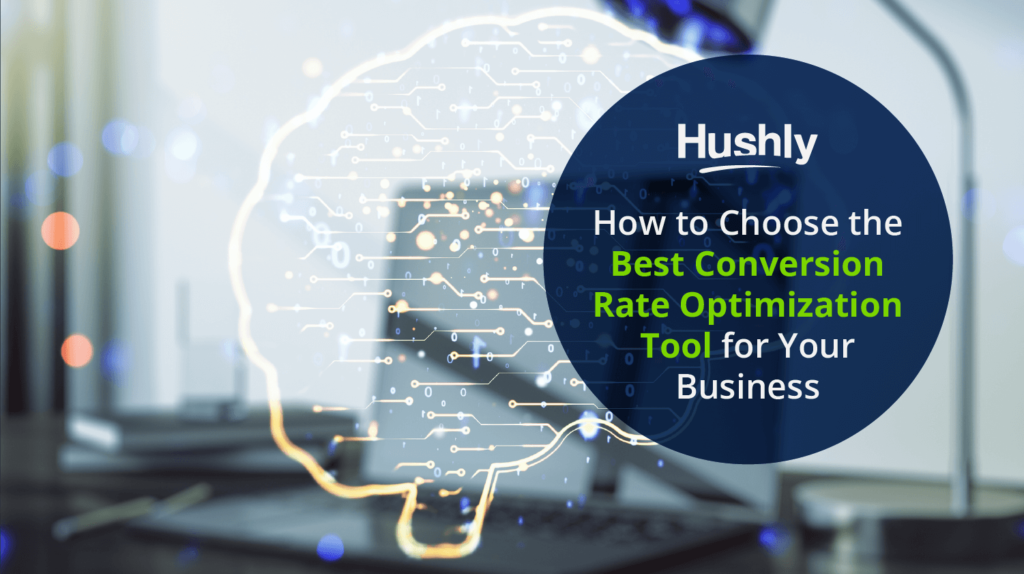Filters
Content Type
Topic
Account-Based Marketing vs. Traditional Marketing: Which Is Best for Your Tech Company?
Traditional marketing techniques were the norm for many years because all marketers could do it. Traditional marketing encompasses offline activities such as print ads, billboards, and cold calling. The traditional framework also encompasses digital outbound marketing strategies that follow the same process.
However, that framework is no longer the go-to option for all companies, especially B2B tech companies.
Account-based marketing is growing in popularity for businesses that want to stay competitive in a saturated market.
Explore the debate of account-based marketing vs. traditional marketing strategies to find the right fit for your needs.

What Is the Difference Between Account-Based Marketing and Outbound Marketing Strategies?
What is the difference between account-based marketing and traditional outbound marketing?
Outbound Marketing
Outbound marketing involves sending out your message to your clients where they are at. Most conventional marketing strategies, like paper ads and cold calls, fall under the outbound marketing category.
These strategies aren’t targeted because you’re sending out messages, hoping your audience sees your content.
Many familiar digital marketing strategies have gone the way of traditional marketing. For example, display ads appear on websites your audience might visit, but there’s no guarantee they will.
Outbound marketing appeals to most marketers because you can spend less per lead and reach large audiences. If you have a broad audience, there’s a very high chance your target customer is in that audience.
Account-Based Marketing
Inbound strategies bring leads into your business. The most targeted inbound marketing strategy is account-based marketing. This level of targeting leads to a higher conversion rate, with 65% of marketers saying their account-based marketing strategy is successful.
Account-based marketing uses extreme personalization to connect one-on-one with high-value accounts. The goal is to show up in front of leads with a customized offer. Then you build a relationship with the client even after they convert.
That way, the client doesn’t just buy once but remains loyal. Account-based marketing is appealing to businesses that survive on long-term clients, like subscription-based tech companies.

Image from Marketing Insider Group
ABM vs. Traditional Marketing: Pros and Cons
Which one comes out on top in the competition of account-based marketing vs. traditional B2B marketing strategies and methods?
Dive into the pros and cons of each and choose the one that best fits your business’s marketing goals.
Account-Based Marketing
Account-based marketing isn’t for everyone. Due to its high costs and time-consuming strategies, it’s not feasible for businesses that sell low-value items. However, it’s very popular among B2B marketers as 94% of them use it.
Explore the pros and cons of account-based marketing and why account-based marketing is better for B2B tech companies.
Pros:
- Hyper-Personalization: ABM allows for a highly personalized approach targeting high-value accounts. This level of personalization can strengthen relationships and increase the likelihood of conversion and ongoing loyalty.
- Focused Targeting: With ABM, you concentrate your marketing efforts on a select group of accounts most likely to convert. This focused targeting can lead to higher engagement and more qualified leads.
- Alignment with Sales: ABM encourages close collaboration between marketing and sales teams. This alignment ensures you closely tie your marketing efforts to the sales team’s goals and strategies. The collaboration results in a more streamlined and effective approach.
- Clearer ROI: Since ABM targets specific accounts, measuring return on investment (ROI) is clearer. You can easily attribute revenue and other key performance indicators directly to the targeted accounts.
Cons
- Resource Intensive: Implementing an ABM strategy can be resource-intensive, requiring detailed research, personalized content creation, and ongoing monitoring. For smaller companies with limited resources, this can be a challenge.
- Extended Sales Cycle: The sales cycle can run longer due to ABM’s hyper-personalization and relationship focus. It may take time to nurture relationships and see results, which may not benefit companies looking for quick wins.
- Risk of Overlooking Opportunities: Focusing solely on a few high-value accounts may lead to missed opportunities with potential clients not initially identified as top-tier targets.
Traditional Marketing Strategies: Pros and Cons
Traditional outbound marketing strategies, including digital and contemporary ones, are usually the go-to strategies. They’re familiar, comfortable, and easy to perform.
You don’t need an intense understanding of marketing and the latest tools to perform traditional marketing. You just throw the net and hope you catch a few fish.
This method can be very profitable for businesses with a broad audience but may not always fit B2B businesses with a specific clientele.
Pros
- Broader Reach: Traditional marketing casts a wider net, reaching a larger audience. This approach is beneficial for tech companies looking to create brand awareness and generate leads at scale.
- Cost-Effective for Mass Communication: Traditional marketing methods, such as advertising on platforms like Google Ads or social media, can be more cost-effective when reaching a broad audience. This is especially advantageous for companies with limited budgets.
- Quick Implementation: You can launch traditional marketing campaigns relatively quickly, which works well for companies that need to generate leads or promote products fast.
Cons
- Lower Relevance for Some Audience Segments: Traditional marketing may not resonate well with specific niches. The one-size-fits-all approach may miss the mark for companies with highly specialized products or services.
- Difficulty in Measuring ROI: Tracking the effectiveness of traditional marketing efforts, especially attribution and conversion, can be challenging. Lack of precision makes determining the actual return on investment harder.
- Limited Relationship Building: Traditional marketing often lacks ABM’s deeper relationships. The focus on mass communication may result in less personalized interactions with potential clients and limit repeat customers.
Account-Based Marketing vs. Traditional Marketing Checklist
While account-based marketing is often the preferred option for high-value B2B tech companies, it’s not always right for every company.
Follow this checklist to find the best marketing strategy for your situation.
Step 1: Identify Your Ideal Customer Profiles (ICPs):
Who do you want to reach?
Understanding if your ideal customer is a broad group or specific accounts helps you understand how narrow your marketing should be.
ABM is most effective when targeting specific high-value accounts. ABM might be a good fit if you can clearly define your ideal customer profiles.
Step 2: Assess Resource Availability
Evaluate whether your team can handle personalized content creation, research, costs, and ongoing monitoring. Account-based marketing costs quickly add up, so you don’t want to jump in unless you’re ready to follow through.
If resources allow, ABM could be a viable strategy.
Step 3: Consider Sales Alignment
If close collaboration between marketing and sales is a priority for your company, ABM’s sales alignment may benefit you. If you’re not there yet, try focusing on that collaboration, and you may be ready down the road.
Step 4: Determine the Sales Cycle Length
How long can you afford your sales cycle to last? If you need to turn quick sales to make a profit, account-based marketing may not fit with your strategy.
ABM may be the way to go if your company can afford a longer sales cycle in exchange for deeper relationships and potentially higher-value clients.
Step 5: Choose Measurement Preferences
How precise do you need to understand the ROI of your marketing?
Traditional marketing is challenging to measure, especially since you have no reliable way of knowing who saw your ad or display.
Measuring ABM, on the other hand, is much easier. You can attribute revenue to specific marketing efforts and accounts.
Account-Based Marketing vs. Traditional Marketing: Which Will You Choose?
Deciding the right marketing strategy comes down to who you want to reach and what action you want them to take.
If you want to leap into account-based marketing but aren’t sure you have the resources, Hushly can help. Our all-in-one conversion cloud offers the tools you need for limitless customization. We help you reach each target account with the most relevant information without requiring hours of your valuable time.
Schedule a demo to learn more about our account-based marketing tools.
The post Account-Based Marketing vs. Traditional Marketing: Which Is Best for Your Tech Company? appeared first on Hushly.



